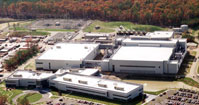






 





|
|
|
Sample ProjectsMusic Building - Austin Peay State University 1990-1993 (1998-2000) 
Clarksville, Tennessee - 80,000 square foot University Music / Mass Communications Building housing a 579 Seat Performing Arts Concert Theater, Choral and Band Rehearsal Spaces, 33 Student Practice Rooms, Dance Studio, Faculty Offices, Teaching Classrooms, TV Studio and a Radio Studio. Facility has been published in AIA Magazine. The Project was a Joint Venture between Stacker/Cook Architects, Inc. and Clark and Associates as the lead firm. The project was initiated because of the Architects belief that the data presented for substantial completion was questionable. Pat Young and a team of field test engineers performed an investigation and functional performance tests of the mechanical equipment and systems and found many areas that were not in compliance with the plans and specifications. The main failures directly affected the acoustical performance of the facility evidence through octave band testing and analysis performed by Mr. Young. These failures included the Performance Hall operating at a NC level of 32 when designed for 15, improper installation of internal acoustical duct liner, and air duct leakage. The Architect condemned the facility and directed that the deficient systems be removed and reinstalled. Mr. Young oversaw and directed reconstruction and then he performed complete functional performance testing and point to point checkout. The result was the Performance Hall operation of a NC level of 13.
Some years later due to a direct hit by an F-4 tornado the building required renovation and IAQ testing and remediation due to mold growth. Mr. Young under Mr. Larry Poos, P.E.s direction performed re-commissioning services and an IAQ investigation to determine the cause and necessary corrective actions. Mr. Poos directed FPT testing and oversaw the team including engineering technicians, IAQ technicians, test and balance engineers (TBEs) and an industrial hygienist.
Architects Clark and Associates Nashville, Tennessee Downtown Main Library 
When the Metropolitan Government of Nashville and Davidson County, Tennessee initiated a $117 million library building program, the agency responsible for the project, Heery turned to ICE for Commissioning Services. The program includes five branch libraries, renovations of three additional branch libraries, and an $81 million, 300,000-square-foot main library in downtown Nashville, being designed by Robert A.M.Stern Architects of New York and Hart Freeland Roberts of Brentwood TN, after a nationwide design competition. The winning design combines an urban architectural landmark with state-of-the-art educational and cultural resource, as well as providing a showcase for public art. While most central library buildings take approximately five years to construct, Nashvilles main library was completed in only three and one-half years, despite $3 million in privately-funded scope changes. The ICE team was brought in during the early construction phase of the project when concerns over construction and customer satisfaction arose. The facility had a limited budget and ICE worked to streamline its service to work within the budget. This included limited walkthrough inspections, and only main power distribution and generator testing. The team included Mr. P. Young who performed design review, construction inspections, and functional testing. Mr. L. Poos, P.E. who was the Commissioning Authority and performed design review and analysis, construction inspections, reporting and documentation, and O&M review. Ms. A. Arnold performed plan review, functional performance test development, O&M review, documentation logging, and engineering assistance. Mr. T. Hedrick performed electrical testing, generator, and emergency power testing. Mr. R. Hurst and J. Merkle performed specific inspections of the sheetmetal duct systems and the control system installation.
Construction Management Heery Austin Peay State University 1999-2001 New Science Building 
A new 240,000 square foot multi-subject facility is the largest project in this System's (State of Tennessee Board of Regents) history - - the Austin Peay State University's Science Building. The building features a 200 seat lecture hall, laboratories, offices, planetarium, library, greenhouse, and cold storage rooms. The HVAC systems consisted of Campus supplied chilled water and steam, 300,000 cfm of supply air with full energy recovery systems. The Building Automation Controls were by Andover Control Systems interface with Phoenix Control through their Solaris system. Fume hoods utilize zone presence sensors to automatically ensure safe hood operation. The rooms were managed by room presence sensors to ensure that all systems were at safe levels when anyone entered the laboratories. ICEs involvement was for the mechanical systems and the team utilized Mr. L. Poos as the Commissioning Authority and he performed plan and specification reviews, chaired commissioning meetings, performed construction inspections, produced documentation, reviewed all control strategy, performed functional performance testing, coordinated training and assisted in the training, and authored final commissioning documents. Ms. A. Arnold performed design review, prepared pre-functional test forms, reviewed O&Ms for compliance, and updated CAD drawings for Commissioning functions. Mr. P. Young performed construction inspections, TAB verification, field testing for FPT tests, developed and executed control scheme changes and updates, deficiency log preparation, established training programs and assisted in report generation. Mr. J. Merkle Controls and TAB testing procedures, Duct Air Leakage Testing. Mr. R. Hurst sheetmetal and equipment.
Architects Clark and Associates Tennessee Bureau of Investigation 1999-2002 Consolidated Regional Facility 
The new headquarters for the Tennessee Bureau of Investigation is an 180,000 square foot consolidated facility incorporating forensic, DNA, ballistics, microbiology, and general laboratory’s. The facility includes offices, gun range, evidence investigation bays, computer rooms and training classrooms. The mechanical systems for the laboratories are variable air volume systems using direct command and response to achieve proper area / room pressures. The office side of the complex incorporates standard VAV systems with hot water reheat coils for space heating. ICEs involvement started at about 30% of the construction phase. The Owner informed the Architect that they would have a Commissioned facility even though not part of the contract specification. This arrangement required us to convince the design and construction team that our effort was to help and assist them in any way possible. After some resistance from the contractors because they felt that the process would be an additional burden ICE was able to alleviate those fears and all parties were extremely helpful. ICEs team utilized Mr. L. Poos as the Commissioning Authority and he performed plan and specification reviews, chaired commissioning meetings, performed construction inspections, produced documentation, reviewed all control strategy, performed functional performance testing, coordinated training and assisted in the training, and authored final commissioning documents. Ms. A. Arnold performed design review, prepared pre-functional test forms, reviewed O&Ms for compliance, and updated CAD drawings for Commissioning functions. Mr. P. Young performed construction inspections, TAB verification, field testing for FPT tests, developed and executed control scheme changes and updates, deficiency log preparation, established training programs and assisted in report generation. Mr. B. Hill P.E. reviewed plans (electrical) and formulated FPT plan, reviewed all design documents and FPT tests. Mr. T. Hedrick formulated electrical Commissioning plan, produced FPT tests and performed them, developed electrical functional performance tests (EFPT), performed construction inspections, reviewed O&M data, and produced final commissioning document for Mr. Hills review. Additional inspections were made by senior engineers specializing in various areas. Mr. J. Merkle controls and TAB testing procedures. Mr. R. Hurst sheetmetal and equipment.
Architects Kline Sweeny Asso. Duke University 2000-2002 Human Genetics Research Center 
The Center for Human Genetics building project is an 110,000 square foot building that houses offices, laboratory space and clinical space for the center, which is a key part of the University's new interdisciplinary Institute for Genome Sciences and Policy. ICEs involvement started at the early construction phase and included both Mechanical and Electrical Commissioning. Team members included Mr. L. Poos P.E. as theCommissioning Authority and he performed plan and specification reviews, chaired monthly commissioning meetings, performed construction inspections, produced documentation, reviewed all control strategy, performed functional performance testing, coordinated training and assisted in the training, and authored final commissioning documents. Ms. A. Arnold performed design review, prepared pre-functional test forms, reviewed O&Ms for compliance, and updated CAD drawings for Commissioning functions. Mr. P. Young performed construction inspections, TAB verification, field testing for FPT tests, assisted in meeting minute production and deficiency log preparation, established training program and assisted in report generation. Mr. B. Hill P.E. reviewed plans (electrical) and formulated FPT plan, reviewed all design documents and FPT tests. Mr. T. Hedrick formulated electrical Commissioning plan, produced FPT tests and performed them, developed electrical functional performance tests (EFPT), performed construction inspections, reviewed O&M data, and produced final commissioning document for Mr. Hills review. Additional inspections were made by senior engineers specializing in various areas. Mr. J. Merkle controls and TAB testing procedures. Mr. R. Hurst sheet metal.
Architects The Hillier Group Copyright 2004 - International Commissioning Engineers LLC |